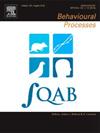Reduction in locomotor activity and freezing time: A dual measure for more accurate fear response in rats
IF 1.3
4区 生物学
Q4 BEHAVIORAL SCIENCES
引用次数: 0
Abstract
Fear conditioning serves as a cornerstone behavioural test for modelling disorders, such as Post-Traumatic Stress Disorder (PTSD) and clinical anxiety, and for evaluating memory. The traditional measure of fear response, namely freezing time, might not encompass all expressions of fear behaviours, leading to potential exclusion of animals demonstrating 'resilient' responses. In this study, we sought to assess the combined utility of reduced locomotor activity and freezing time as a dual-measure for a more accurate evaluation of the fear response in Sprague-Dawley rats. Both cued and contextual conditioning paradigms were employed. Behavioural outcomes were meticulously recorded via a state-of-the-art, fully automated Multi-Conditioning System. The results indicated a significant correlation between freezing time and diminished locomotor activity, underscoring that both measures represent congruent facets of the fear response. Each conditioning paradigm led to a notable reduction in locomotor activity in response to the conditioned cues. A pivotal insight from our findings is the risk associated with solely relying on freezing time, which could inadvertently overlook animals manifesting alternate fear responses. Conversely, gauging reduced locomotor activity facilitates a more precise discernment of animals that are genuinely resilient to fear conditioning. Our research champions the concurrent assessment of reduced locomotor activity and freezing time as a refined method to interpret fear response in rodents, particularly for identifying animals that exhibit fear-related behaviors but do not meet traditional freezing thresholds, promising to bolster the integrity of fear conditioning investigations and offer a deeper insight into fear behaviours.
减少运动活动和冻结时间:对大鼠更准确的恐惧反应的双重测量
恐惧条件反射是模拟障碍的基础行为测试,如创伤后应激障碍(PTSD)和临床焦虑,以及评估记忆。传统的恐惧反应测量,即冻结时间,可能不包括恐惧行为的所有表达,导致潜在的排除动物表现出“弹性”反应。在这项研究中,我们试图评估减少运动活动和冻结时间作为双重测量的综合效用,以更准确地评估Sprague-Dawley大鼠的恐惧反应。提示条件反射范式和情境条件反射范式均被采用。行为结果通过最先进的全自动多条件调节系统精心记录。结果表明,冻结时间与运动活动减弱之间存在显著相关性,强调这两种测量方法代表了恐惧反应的一致方面。每一种条件反射模式都导致对条件提示的运动活动显著减少。从我们的研究结果中得出的一个关键见解是,仅仅依赖冻结时间的风险,可能会无意中忽视动物表现出的交替恐惧反应。相反,测量减少的运动活动有助于更精确地辨别出真正能适应恐惧条件反射的动物。我们的研究支持减少运动活动和冻结时间的同时评估,作为解释啮齿动物恐惧反应的一种改进方法,特别是用于识别表现出恐惧相关行为但不符合传统冻结阈值的动物,有望加强恐惧条件反射调查的完整性,并提供对恐惧行为的更深入了解。
本文章由计算机程序翻译,如有差异,请以英文原文为准。
求助全文
约1分钟内获得全文
求助全文
来源期刊

Behavioural Processes
生物-动物学
CiteScore
2.70
自引率
7.70%
发文量
144
审稿时长
4-8 weeks
期刊介绍:
Behavioural Processes is dedicated to the publication of high-quality original research on animal behaviour from any theoretical perspective. It welcomes contributions that consider animal behaviour from behavioural analytic, cognitive, ethological, ecological and evolutionary points of view. This list is not intended to be exhaustive, and papers that integrate theory and methodology across disciplines are particularly welcome.
 求助内容:
求助内容: 应助结果提醒方式:
应助结果提醒方式:


